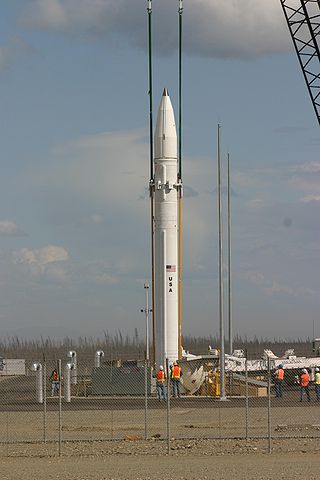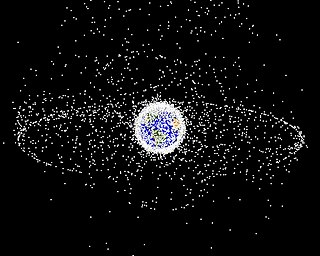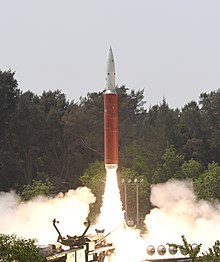
An anti-ballistic missile (ABM) is a surface-to-air missile designed to counter ballistic missiles. Ballistic missiles are used to deliver nuclear, chemical, biological, or conventional warheads in a ballistic flight trajectory. The term "anti-ballistic missile" is a generic term for a system designed to intercept and destroy any type of ballistic threat; however, it is commonly used for systems specifically designed to counter intercontinental ballistic missiles (ICBMs).

Anti-satellite weapons (ASAT) are space weapons designed to incapacitate or destroy satellites for strategic or tactical purposes. Although no ASAT system has yet been utilized in warfare, a few countries have successfully shot down their own satellites to demonstrate their ASAT capabilities in a show of force. ASATs have also been used to remove decommissioned satellites.

Space warfare is combat in which one or more belligerents are in outer space. The scope of space warfare includes ground-to-space warfare, such as attacking satellites from the Earth; space-to-space warfare, such as satellites attacking satellites; and space-to-ground warfare, such as satellites attacking Earth-based targets. Space warfare in fiction is thus sub-genre and theme of science fiction, where it is portrayed with a range of realism and plausibility. In the real world, international treaties are in place that attempt to regulate conflicts in space and limit the installation of space weapon systems, especially nuclear weapons.

The Kessler syndrome, proposed by NASA scientists Donald J. Kessler and Burton G. Cour-Palais in 1978, is a scenario in which the density of objects in low Earth orbit (LEO) due to space pollution is numerous enough that collisions between objects could cause a cascade in which each collision generates space debris that increases the likelihood of further collisions. In 2009, Kessler wrote that modeling results had concluded that the debris environment was already unstable, "such that any attempt to achieve a growth-free small debris environment by eliminating sources of past debris will likely fail because fragments from future collisions will be generated faster than atmospheric drag will remove them". One implication is that the distribution of debris in orbit could render space activities and the use of satellites in specific orbital ranges difficult for many generations.

The ASM-135 ASAT is an air-launched anti-satellite multistage missile that was developed by Ling-Temco-Vought's LTV Aerospace division. The ASM-135 was carried exclusively by United States Air Force (USAF) F-15 Eagle fighter aircraft.
On 11 January 2007, China conducted an anti-satellite missile test. A Chinese weather satellite—the FY-1C polar orbit satellite of the Fengyun series, at an altitude of 865 kilometres (537 mi), with a mass of 750 kilograms (1,650 lb)—was destroyed by a kinetic kill vehicle traveling with a speed of 8 km/s (18,000 mph) in the opposite direction. It was launched with a multistage solid-fuel missile from Xichang Satellite Launch Center or nearby.

The Indian Ballistic Missile Defence Programme is an initiative to develop and deploy a multi-layered ballistic missile defence system to protect India from ballistic missile attacks. It was launched in 2000 after the Kargil War by the Atal Bihari Vajpayee government. Testing was carried out and continuing as of 2006, and the system was expected to be operational within four years according to the head of the country's missiles development programme, Vijay Kumar Saraswat.

USA-193, also known as NRO Launch 21, was a United States military reconnaissance satellite launched on 14 December 2006. It was the first launch conducted by the United Launch Alliance (ULA). Owned by the National Reconnaissance Office (NRO), the craft's precise function and purpose were classified. On 21 February 2008, it was destroyed as a result of Operation Burnt Frost.
The Integrated Space Cell was the nodal agency within the Government of India with oversight of the security of its space based military and civilian hardware systems. It was to be jointly operated by all the three services of the Indian Armed Forces, the civilian Defence Research and Development Organisation and the Indian Space Research Organisation (ISRO). This agency was superseded by Defence Space Agency in 2019.[better source needed]
Strictly speaking, a satellite collision is when two satellites collide while in orbit around a third, much larger body, such as a planet or moon. This definition is typically loosely extended to include collisions between sub-orbital or escape-velocity objects with an object in orbit. Prime examples are the anti-satellite weapon tests. There have been no observed collisions between natural satellites, but impact craters may show evidence of such events. Both intentional and unintentional collisions have occurred between man-made satellites around Earth since the 1980s. Anti-satellite weapon tests and failed rendezvous or docking operations can result in orbital space debris, which in turn may collide with other satellites.
China's anti-satellite (ASAT) program has been under development since 1964. The ASAT program has since been moved from Program 640 to Program 863, the General Armaments Department and the State Administration for Science, Technology and Industry for National Defense. Since its inception, the ASAT program has made progress on the development of three ASAT capable Systems: direct fire, directed-energy weapon, and microsatellites. Tests of these systems have either been directly acknowledged by the PRC, or reported on as ASAT capable. China is pursuing a broad and robust array of counterspace capabilities, which includes direct-ascent antisatellite missiles, co-orbital antisatellite systems, computer network operations, groundbased satellite jammers, and directed energy weapons.
India has studied, produced and used various strategic and tactical missile systems since its independence. Decades long projects have realised development of all types of missile systems including ballistic, cruise, anti-ship, air-defence, air-to-air and anti-missile systems. India is one of seven countries in the world with intercontinental ballistic missiles (ICBMs) and one of four countries with anti-ballistic missile systems. Since 2016, India has been a member of Missile Technology Control Regime (MTCR).

G. Satheesh Reddy is an Indian aerospace scientist who served as the thirteenth chairman of the Defence Research and Development Organisation (DRDO) from 2018 to 2022. He is also the chairman of the Governing Body of the Aeronautical Development Agency, and the Scientific Adviser to Raksha Mantri.
System A-235 PL-19 Nudol is a Russian hypersonic anti-ballistic missile and anti-satellite weapon system in development. It is designed to deflect a nuclear attack on Moscow and other regions within European Russia. The main developer of the system is JSC Concern VKO Almaz-Antey. The new system should replace the current one — A-135. The two main differences will be that the A-235 will use conventional warheads and it will be road-mobile.

Microsat-R was claimed to be an experimental imaging satellite manufactured by DRDO and launched by Indian Space Research Organisation on 24 January 2019 for military use. The satellite served as a target for an anti-satellite test on 27 March, 2019.

The PSLV-C44 was the 46th mission of the Indian Polar Satellite Launch Vehicle (PSLV) program. It was the first flight of PSLV-DL, having 2 strap-on boosters and placed a primary payload Microsat-R and a secondary payload of Kalamsat V2 in Sun-synchronous orbits.
The Defence Space Agency (DSA) is an integrated tri-services agency of the Indian Armed Forces headquartered in Bengaluru, Karnataka, India. The agency is tasked with operating the space-warfare and Satellite Intelligence assets of India. The DSA draws personnel from all three branches of the Armed Forces.

Kosmos-1408 was an electronic signals intelligence (ELINT) satellite operated by the Soviet Union. It was launched into low Earth orbit on 16 September 1982 at 14:55 UTC, replacing Kosmos-1378. It operated for around two years before becoming inactive and left in orbit.
This article consists of projects of the Defence Research and Development Organisation.
















